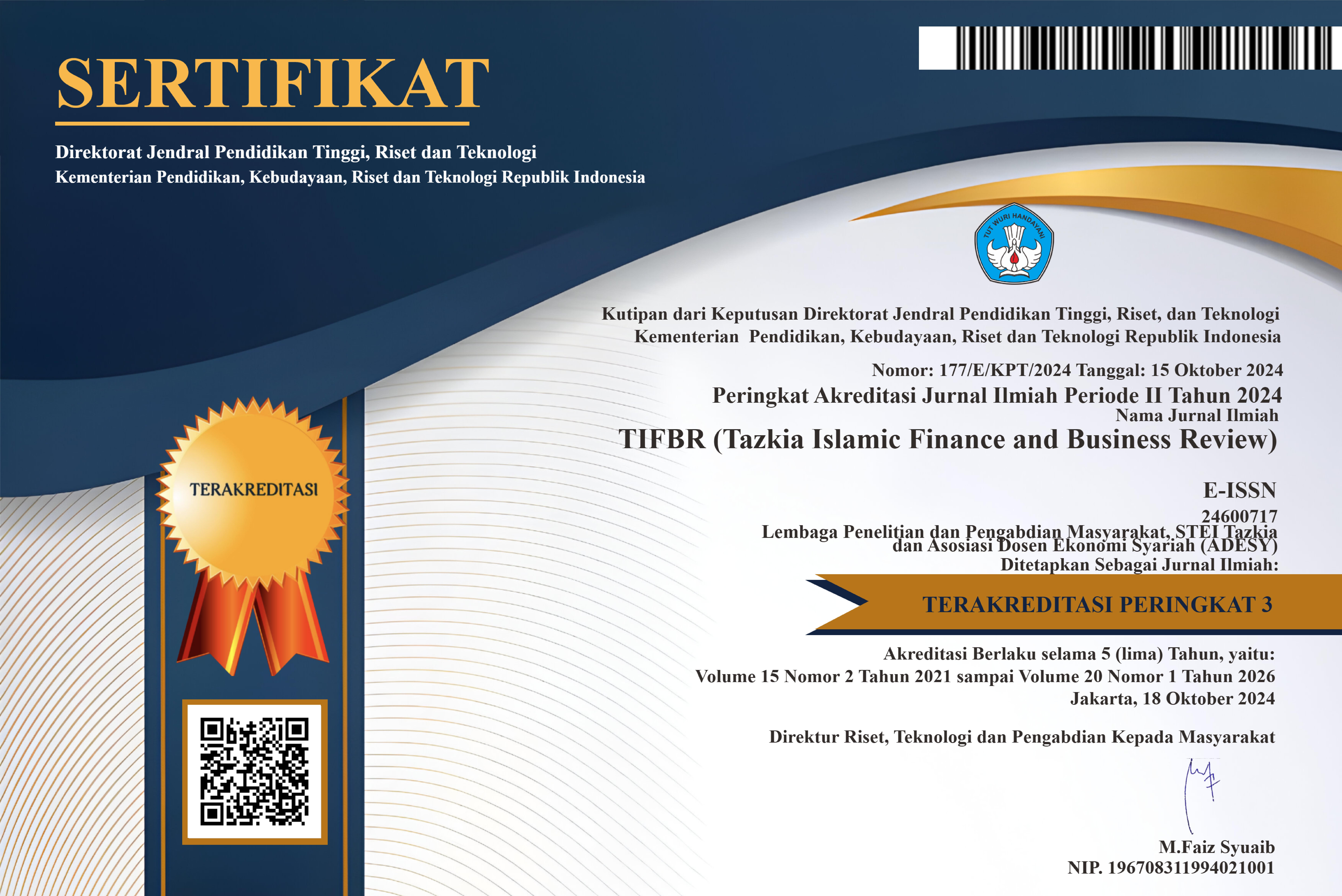MASLAHAH AND STRATEGY TO ESTABLISH A SINGLE STATE-OWNED ISLAMIC BANK IN INDONESIA
DOI:
https://doi.org/10.30993/tifbr.v10i1.97Keywords:
State-owned Islamic bank, Conversion, AcquisitionAbstract
Objective - The market share of Islamic banking in Indonesia has continually decreased from 4.89% in 2013 to 4.85% in 2014 and 4.83% in 2015. As a result, the idea to establish a single state owned Islamic Bank occurs. This conceptual paper aims to contribute the maslahah framework regarding the future of Islamic banks in Indonesia.
Methods - The methodology that used in this paper is a qualitative method which supported by quantitative data that align with the theory of the benefit of the Ummah (maslahah) and the community theory.
Results - The breakthrough to increase the market share and deliver Indonesia becoming an Islamic financial hub is the option to convert the BRI as the biggest retail bank to a full fledge Islamic bank, and the next action is to acquire the Islamic banks which are subsidiary of conventional state-owned banks (Bank Syariah Mandiri-BSM, Bank Nasional Indonesia Syariah-BNIS, Bank Rakyat Indonesia Syariah-BRIS, and Bank Tabungan Negara Syariah-BTNS).
Conclusions - Establishing a single state-owned Islamic bank is beneficial for the future of Islamic banks in Indonesia
References
Alamsyah, H., (2012). Perkembangan dan prospek perbankan syariah Indonesia: Tantangan dalam menyongsong MEA 2015. Ceramah Ilmiah Ikatan Ahli Ekonomi Islam (IAEI), Milad ke-18 IAEI; 13 April 2012
Alamsyah, H., (2013). Opening Speech Discussion at the Ministry of State Own Entreprises with Thema Expect Of Islamic Bank State Own Etreprises Realization. Jakarta.
Arafah, W., & Nugroho, L., (2016). Maqhashid Sharia in Clean Water Financing Business Model at Islamic Bank. International Journal of Business and Management Invention, Vol.5 No. 2, pp. 22-32.
Anshori, Abdul Ghofur., (2010). Establishment of Islamic Banking and Through Acquisitions Conversion. Press UII Yogyakarta : Yogyakarta.
Wajdi Dusuki, A. (2008). Banking For The Poor: The Role Of Islamic Banking In Microfinance Initiatives. Humanomics, Vol. 24 No. 1, pp. 49-66..
Bank Indonesia. (2013). Cited by Investor Daily Indonesia. Available online at: http://www.investor.co.id/home/60-penduduk-indonesia-kelas-menengah/55380#Scene_1
Bank Indonesia. (2015). The Banking Statistics Indonesia. March.
Bank Indonesia. (2013). Islamic Banking Statistics Indonesia. March.
Bank Indonesia. (2015). Outlook Islamic Bank.
Chapra, Umar., (2001). The Future of an Islamic Economic Perspective (Landscape New Economic Future). P. 154-155. Shari'ah Economics and Banking Institute (SEBI) : Jakarta.
Choudhury, M. A., (2010). Islamic Perspective of Socioeconomic Development. Journal of Islamic Economics, Banking and Finance, Vol. 6 No. 3, pp. 37-54
Gupta, A., (2010). Financial Crisis Enforcing Global Banking Reforms. Business Strategy Series, Vol. 11 No. 5, pp. 286-294..
Masyita, D., (2015). Why the do the people see a financial system as a whole very important ?. Journal of Islamic Monetary Economics and Finance, Vol.1 No.1, pp.79-106.
Mitton, T., (2002). A Cross-Firm Analysis of The Impact of Corporate Governance On The East Asian Financial Crisis. Journal Of Financial Economics, Vol 64 No2, pp. 215-241.
Nurtantiono, Andri., (2011). Community, Media Distribution Business To Business (B2B), Business To Consume (B2C) To Consume And Consume (C2C). Graduations. Vol. Issue 25, March 2011.
Nugroho, L., & Husnadi, T. C., (2014). State-Owned Islamic Bank (BUMN) in Realizing The Benefit of Ummah (Maslahah) and Indonesia as Islamic Financial Center in The World. Proceedings in 11th International Research Conference on Quality, Innovation and Knowledge Management. Bandung.
Prambudi, Teguh S., (2008). Life in the Central Community. SWA 23 / XX / IV / 3-12 November 2008.
Rival, Veithzal. Nurudin, Amiur, Ananda Arfa, Faisal., (2012). Islamic Business And Economic Ethics. P. 58-59. PT. Earth Literacy : Jakarta.
Sudarsono, H., (2009). Dampak Krisis Keuangan Global terhadap Perbankan di Indonesia: Perbandingan antara Bank Konvensional dan Bank Syariah. La_Riba, Vol. 3 No.1, pp. 12-23.
Syufaat., (2011). The Proces s of Establishment of The Islamic Bank In The World of Islam. Suhuf. Vol. 23 No. 1.pp.41-55.
Uribe, M., & Yue, V. Z., (2006). Country Spreads and Emerging Countries: Who Drives Whom?. Journal of international Economics, Vol.69 No 1, pp.6-36.
--------, (2015). The Pew Research Center's Forum On Religion & Public Life. Available online at: http://www.pewforum.org/2015/04/02/muslims/pf_15-04-02_projectionstables74/
Downloads
Published
How to Cite
Issue
Section
License

Tazkia Islamic Finance and Business Review (TIFBR) is licensed under a Creative Commons Attribution-NonCommercial 4.0 International License.
Authors who publish with this journal agree to the following terms:
- Authors retain copyright and grant the journal right of first publication with the work simultaneously licensed under a Creative Commons Attribution License that allows others to share the work with an acknowledgment of the work's authorship and initial publication in this journal.
- Authors are able to enter into separate, additional contractual arrangements for the non-exclusive distribution of the journal's published version of the work (e.g., post it to an institutional repository or publish it in a book), with an acknowledgment of its initial publication in this journal.
- Authors are permitted and encouraged to post their work online (e.g., in institutional repositories or on their website), as it can lead to productive exchanges, as well as earlier and greater citation of published work (See the Effect of Open Access).

















